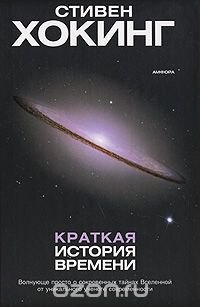The book "A Brief History of Time" written by Stephen Hawking

Publisher: Amfora, 2010
Hardcover, 231 pp.
Book on Ozon.ru
After watching the translation of the video “Richard Feynman: Magnets and Why Questions?” I remembered the equally famous physicist Stephen Hawking and his works.
And he remembered for a reason. Richard Feynman in the video tries to explain a seemingly simple thing - why magnets repel each other and attract each other. And most of the video explains that without special knowledge some things are impossible to understand, and the more we simplify the model, the further we go from the truth. It may be so, but for me, who knows only a school course in physics, Stephen Hawking’s book A Brief History of Time, which explains this and many other questions, was a revelation. Despite the fact that the book is very popular, on Habré found only a few references to it.
The book was first published in 1988. The author, in a simple and understandable language, does not use formulas (except for E = mc 2 ), tells us about the nature of the Universe, space and time, black holes and current scientific theories explaining them.
Logically, the book can be divided into 3 parts:
1. What came before the Einstein theories of relativity;
2. General theory of relativity (large-scale structure of the universe);
3. Quantum mechanics (phenomena in extremely small scales, as one millionth one millionth of a centimeter).
')
Reading, you find yourself at the forefront of science and understand the problems that confront researchers. Stephen Hawking himself is looking for a "quantum theory of gravity" that would unite the general theory of relativity and quantum mechanics.
This is how Stephen Hawking explains the formula known from school E = mc 2 (where E is energy, m is mass, and c is the speed of light):
"In fact, the speed of an object can never reach the speed of light, since then its mass would become infinitely large, and since mass is equivalent to energy, it would take an infinitely large energy to achieve such speed ... Only light and other waves that do not have" their own " mass, can move at the speed of light. "
A few more quotes:
“Einstein suggested a revolutionary nature: gravity is not an ordinary force, but a consequence of the fact that space-time is not flat, as previously thought; it is curved by the mass and energy distributed in it. Such bodies as the Earth are not at all compelled to move by gravitational force along curved orbits; they move along lines that in curved space most closely correspond to straight lines in ordinary space and are called geodesics ... According to the general theory of relativity, bodies always move along straight lines in four-dimensional space-time, but we see that in our three-dimensional space they move along curved trajectories ... The mass of the Sun bends space-time so much that, although the Earth moves in a straight line in four-dimensional space, we see that in our three-dimensional space it moves in a circular orbit ".
“Near a massive body like the Earth, time must flow more slowly ... To an observer located at a high altitude it should seem that everything is slower below. This prediction was tested in 1962 with the help of two very accurate clocks arranged: one at the very top of the water tower, and the second at its foot. It turned out that the lower clocks that were closer to the Earth, in exact accordance with the general theory of relativity, were slower ”.
PS IMHO, the book is worth reading for basic knowledge. If something is of interest, you can delve into the work of the scientists named in the book. Perhaps, if I had read this book at school, I would have treated physics completely differently.
PPS In 2005, “The shortest history of time” was published , where the discoveries of recent years were taken into account. I did not read it myself, so I cannot recommend it. Who read - write in the comments, as it is.
Update 04/24/2010. Thanks for the karma, moved to the "Reading room".
Source: https://habr.com/ru/post/90597/
All Articles